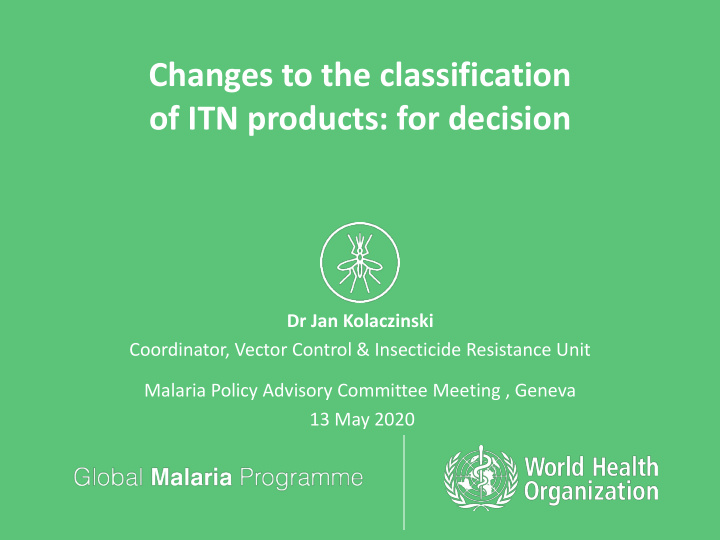



Changes to the classification of ITN products: for decision Dr Jan Kolaczinski Coordinator, Vector Control & Insecticide Resistance Unit Malaria Policy Advisory Committee Meeting , Geneva 13 May 2020
Background • Identified inconsistencies in the classification and public health evaluation of ITNs when compared to other vector control products • Arrival of new vector control products, including ITNs, with complex chemical formulations requires a revisit of ITN classification and evaluation processes / standards • Consulted broadly with MPAC, VCAG and externally with partners through a notice of intent (NoI) published February 2020 • Q&A published in response to feedback to the NoI • Today’s session presents the revised ITN classification developed based on the proposed policy, public comments and the next steps • Overall aim is to balance the public health need for deployment of new vector control tools with WHO’s responsibility of providing evidence-based guidance to WHO Member States.
Proposed New ITN Classes: for decision 1. ITNs designed to kill host-seeking insecticide-susceptible mosquito populations that have demonstrated public health value compared to untreated nets and whose entomological effects consist of killing and reducing the blood-feeding of insecticide-susceptible mosquito vectors : Existing prequalified pyrethroid-only nets. Policy recommendation in place. 2. ITNs designed to kill host-seeking insecticide-resistant mosquitoes and for which a first-in- class product has demonstrated public health value compared to the epidemiological impact of pyrethroid-only nets: This class is provisionally thought to include both insecticide treatments with active ingredients other than pyrethroid-based formulations and nets with synergists. It includes pyrethroid-PBO nets that are currently covered under an interim WHO policy recommendation. The class would be expanded to include pyrethroid + chlorfenapyr nets once their public health value has been demonstrated by means of at least two geographically separate epidemiological trials. The class would then be expanded to also include other products with the same entomological effect but with different chemical modes of action to pyrethroid-only nets without the need for further epidemiological trials. 3. ITNs designed to sterilize and/or reduce the fecundity of host-seeking insecticide-resistant mosquitoes for which a first-in-class product has demonstrated public health value compared to the epidemiological impact of pyrethroid-only nets: This class is provisionally thought to include pyrethroid + pyriproxyfen nets and will be created once the public health value of a first-in-class ITN product containing an insect growth regulator has been demonstrated by means of at least two geographically separate epidemiological trials.
Next Steps Implementation of the revised classification requires: • Revision of ITN testing guidelines to allow comprehensive evaluation of nets other than pyrethroid-PBO products. • Identification and closure of existing data gaps on new types of nets currently prequalified (incl. pyrethroid+PBO nets). This has been initiated by PQT-VC • Update WHO documentation on the evaluation process to reflect changes made to ITN classification and evaluation • Establishment of a process within WHO to define similarities for existing and future ITN products • Review of the ITN classification within a period of 3 years to establish whether the revised classification continues to capture the available products and those under development, and whether there may be opportunities to further simplify classification
Recommend
More recommend